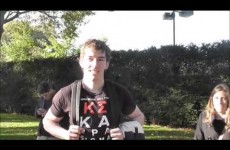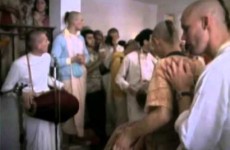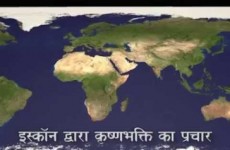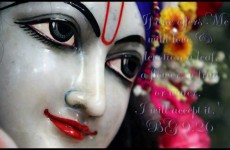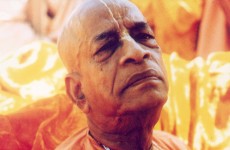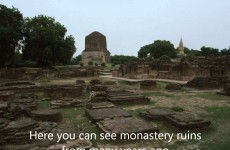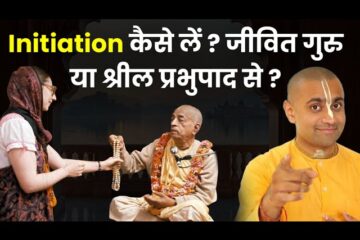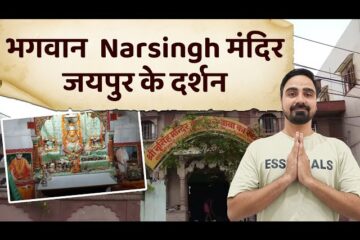George Harrison became interested in Eastern religion and mysticism when he played sitar on the set of The Beatles’ 1965 movie Help!, and when he received a book on Hinduism on a beach in the Bahamas.This interest led to a number of visits to India and a lifelong friendship with sitar master Ravi
Shankar. In 1967, he and his fellow Beatles met with the Maharishi Mahesh Yogi and, early the following year, they all headed off to Rishikesh to study with the Transcendental Meditation guru.
George was already aware of the devotees of Krishna before meeting the movement’s leader, A.C Bhaktivedanta Swami Prabhupada, and had purchased 20 copies of the Happening album, the first recording by Swami Prabhupada and his disciples. But it wasn’t until 1969 that George met Shyamasundara dasa in the London offices of Apple Records, The Beatles’ record company. “Where have you been? I’ve been waiting two years to meet you fellas,” was how he greeted the devotee. Shyamasundara and five others had come to London to start a branch of ISKCON and they had sent apple pies and clockwork apples with the Hare Krishna mantra written on them to the Apple headquarters. This initial meeting led to the recording of “Hare Krishna Mantra”, credited to Radha Krishna Temple (London), with George and apparently Paul and Linda McCartney and Ginger Baker all in the studio helping. George produced the song and further recordings, as well as attending an Apple-organised press conference for the Temple in a park at Sydenham, south London, and their appearance on BBC-TV’s Top of the Pops, where they performed “Hare Krishna Mantra” (although he did not appear in front of the cameras). The single reached the charts in twenty countries, doing particularly well in Czechoslovakia and Germany,[3] and was even sung one afternoon by 40,000 people at Wembley. Author Peter Lavezzoli has described the Harrison-assisted success of “Hare Krishna Mantra” as “an astonishing feat”. Swami Prabhupada made a deep impression on George: “Most of these yogis say ‘Look at me, I am the divine incarnation, let me help you,'” he explained. “Prabhupada said: ‘I am the servant of the servant of the servant.'” When George once asked Srila Prabhupada if he should also shave his head and join the temple, Prabhupada replied that he could do more for Krishna through his music. Many years previously, the great-grandfather of the Hare Krishna movement, Bhaktivinode Thakur, had predicted a day when the Maha Mantra and songs of Krishna would be sung throughout the world in the local musical style and in the local language. George would be one of the first to help towards making that prediction come true. When Prabhupada heard George’s orchestrated version of the Govindam prayers for the first time, he was moved to tears and asked for it to be played every morning in each of the movement’s temples, which still happens to this day.
Srila Prabhupada once remarked that George Harrison was “more” than his disciple. During his final earthly pastimes in Vrindavan, 1977, Prabhupada took off his gold ring and requested that it be given to George. Due to his sincere and influential devotional service, George Harrison had pleased Lord Krsna’s pure devotee, Srila Prabhupada.
“The relationship between Srila Prabhupada and George Harrison was very close, and Srila Prabhupada regarded George as his son. When Bhaktivedanta Manor was donated, Srila Prabhupada said of George, ‘Because he has given shelter to Krsna by providing this temple, Krsna will surely provide shelter for him.’ Just before Srila Prabhupada left this world in 1977, he removed the ring on his right hand and said to the disciples around him, ‘This is for George, give it to him.'”
Srila Prabhupada appreciated George Harrison’s humility and how he sincerely tried his best to utilize his God-given talents to spread the Hare Krsna mantra all over the world. He was bold and convinced in his devotion. Tribhuvannatha Prabhu used to see him quite regularly, and often said that George was very grateful and humble in his dealings. He especially liked prasadam, and never made a fuss about being an important rock star or drew attention to himself. In fact, when he attended public events at the temple, he remained quiet and unassuming. At other times, he was often seen chanting Hare Krsna sincerely on his japa beads.
Many devotees joined the Hare Krsna movement at least in part because of George Harrison. He legitimized Hare Krsna and Indian culture in the West because of his exalted status of being in The Beatles.
George Harrison was a devotee of Lord Krsna who Srila Prabhupada once referred to as his “uninitiated disciple.” He was a devotee at heart — an individual who had the courage of his conviction along with an order from Srila Prabhupada to spread the Hare Krsna mantra worldwide. A true success story and a life well lived. Thank you, George. You’re dearly loved and appreciated by so many all over the world.











